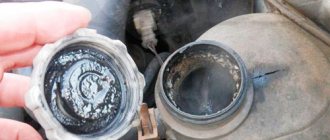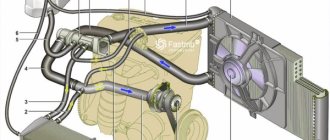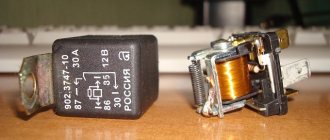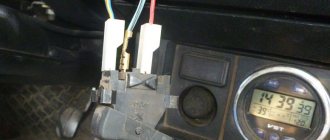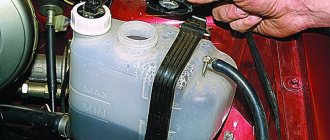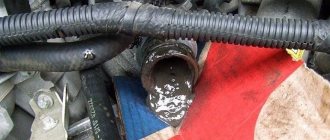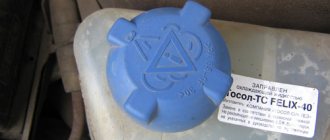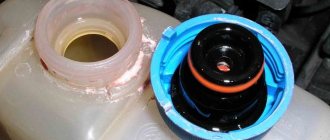The presence of air in the cooling system is fraught with problems for both the engine and other components of the car. In particular, overheating may occur or the stove will heat poorly. Therefore, it is useful for any motorist to know how to remove an air lock from the cooling system. This procedure is quite trivial, so even a beginner and inexperienced car enthusiast can do it. Due to its importance, we will talk about three methods of removing air. But first, let's talk about how to understand that air jams are occurring and the reasons for their occurrence.
Removing air from the heating system of the VAZ-2110
Problems with the heating system of domestic cars are far from uncommon. Most often, car owners pay attention to existing faults in winter, when the temperature outside the windows is very different from comfortable. One of the possible reasons for the flow of cold air into the vehicle interior instead of hot air may be the presence of air blockage in the heating system.
In this article, we will look at the reasons for airing in the VAZ-2110 stove, and how to remove air from the heating system of the vehicle.
Articles
- 21110-1008650-00 – plastic screen (only for 11183);
- 21120-1008658-00 – rubber screen pin;
- 21080-1311065-00 (-01, -03) – expansion tank plug;
- 21080-1311067-00 – gasket for the plug.
Do you only need distillate?
We tried to expel air from the system, but on the VAZ-2114 the entire “plug” takes up 100-150 ml. This means you don’t have to add anything at all to the tank. You can also add regular distilled water.
It is easier to find a 100 ml package of distillate at a pharmacy or battery store.
Source
Reasons for the occurrence of an air lock in the heating system of the VAZ-2110
An air lock most often appears in the pipes and hoses of the engine cooling system. The appearance of a blockage will negatively affect not only the operation of the heater, but also the functionality of the vehicle engine. Air-filled hoses lose their capacity, which causes overheating of the power unit and boiling of the coolant in the heating system. If you do not remove the air lock, the consequences can be varied - from damage to the heater radiator to overheating of the car's power unit.
The causes of blockage can be different. Sometimes it is not enough to simply force the air out of the system, but it is necessary to eliminate the original source of the problem. One of the most popular reasons is improper replacement of coolant. In such a situation, it is enough to simply remove the air lock and then follow the manufacturer’s instructions when adding or replacing antifreeze. To perform the work correctly, it is important to unscrew the necessary hoses and pipes.
Air leaks are often caused by depressurization or damage to parts of the engine cooling and interior heating systems. The cause of depressurization is poorly tightened clamps on hoses and pipes. As a result, air enters through small holes and air pockets form. In this case, you first need to check the reliability of the hose fastenings, and only after that you need to remove the plug. The presence of damaged parts in the cooling system can be identified by traces of leaking antifreeze in the engine compartment. If there are such traces, then it is necessary to find and replace the element that has become unusable, otherwise after removing the plug it will appear again.
Determining the cause
Video: Second car with a problem: the stove does not heat - there is air in the system!
The main indicator of the appearance of an air lock is that the stove is not working or is not working well. But this can also happen due to the fault of the same thermostat. If it gets stuck in the open position (the antifreeze constantly moves in a large circle), then the engine simply will not reach operating temperature and the stove will not heat up.
Therefore, if you decide to fix problems with the cooling system, first check the operation of the thermostat. This is easy to do; let’s look at the steps using the VAZ-2109 as an example.
Start checking with the engine cooled down. We start the engine, open the hood, find the upper large pipe going to the radiator - it is a supply pipe and comes from the thermostat, we test its temperature with our hands. If the thermostat is working properly, the pipe remains cold until the engine warms up to operating temperature. As the engine reaches temperature and the thermostat opens, the pipe will begin to heat up.
If the thermostat is functioning normally, but the heating system is not working, there is likely an air lock in the system that needs to be expelled. But before that, eliminate the cause of its appearance. To do this, carefully inspect the connections of the system pipelines to see if there are any leaks.
Inspect the water pump and motor where the cylinder block meets the head. Traces of antifreeze leakage indicate damage to the gaskets. Eliminate the cause of the air lock, and only then solve the issue of airing.
A common cause of a plug is a violation of the technology for replacing and adding antifreeze; the problem with a non-heating stove is associated with it.
Video: How to avoid air in the cooling system when filling with antifreeze.
Methods for venting the VAZ-2110 stove
Sometimes, after adding or completely replacing antifreeze, the stove on a VAZ-2110 stops heating. If the heater core is hot, then there is a high probability that air has entered the heater. If the VAZ-2110 stove is airy, it is necessary to remove the air from the heater for its normal functioning.
There are several effective, simple ways to fix the problem that even a novice driver can handle.
The first option involves removing the air plug using simple manipulations in the engine compartment of the car. First you need to unscrew the cap of the expansion tank. In the engine compartment near the radiator of the car, you need to find hoses for supplying and discharging coolant. The air must be expelled by sharply pressing both hoses for a short time. After this, tighten the tank cap and check whether the air lock has been removed. To do this, you need to start the car and turn on the heater at maximum speed. If the problem is not resolved, you need to look for the cause elsewhere, or try the following method.
To eliminate air from the stove using the second method, you need to find an overpass or a high hill, and place the car so that its front part is as high as possible. After this, you need to start the car and let it idle for several minutes. If such actions do not produce results, you can repeat the procedure by adding accelerator pressure with the gas pedal.
After removing the plug, you need to add antifreeze to the expansion tank to the normal level and close the tank lid tightly. You should not add liquid very suddenly, as this may cause the air to reappear.
The third method of eliminating the problem when the VAZ-2110 stove is airing is the most effective and efficient. However, this method is slightly more difficult to implement. To make the work more convenient, you may need the help of a friend.
First you need to find and disconnect the antifreeze drain hose. This must be done very carefully, as antifreeze may leak from it or from the fitting. If liquid leaks, you need to pinch the hole with your finger. If there is an air lock, then antifreeze will not flow from the hose.
After this, you need to slowly add antifreeze prepared in advance. It is necessary to fill until it flows from the hose or its level reaches the maximum value in the expansion tank.
If coolant leaks, it means that air has left the system. All that remains is to connect the hose to the fitting and secure it with a clamp. After this, you can close the tank lid, start the engine and check the operation of the stove.
In case of a situation where the level of antifreeze in the tank is maximum, and it does not flow from the hose, then you will need the help of a friend. You need to start the car and parallel the hole in the hose tightly with your finger and wait for liquid to flow out of it. Sometimes it begins to flow out of the fitting faster than from the hose. In this case, you need to close the fitting with your finger and wait until the antifreeze comes out of the hose. Only after this can the hose be installed in its place.
If it is not possible to remove the air plug for some reason, the same operation can be repeated with the coolant supply hose.
How to expel air, method No. 1
- Remove the hose from the throttle body heating.
- Open the cap of the expansion tank, cover the neck with a clean rag and blow into the tank.
- When antifreeze starts flowing from the removed tube, quickly put the hose back in place and tighten it with a clamp.
Attention! Coolant is a toxic substance, so we recommend that you use other methods to solve the problem.
Let's sum it up
Air entering the vehicle heater can negatively affect not only the functionality of the heater and comfort in the cabin, but also affect the operation of more significant units and parts in the car. Timely detection and elimination of the problem will help you save on the purchase of expensive heater components and repairs to the car’s power unit.
Be very attentive to even seemingly frivolous problems in the operation of your vehicle. Simple preventive measures to care for the interior heating elements will have a positive impact on the functionality of the vehicle as a whole.
How to remove an air lock on a VAZ 2110, VAZ 2111, VAZ 2112?
Welcome! Air lock - it forms in the pipes of the cooling system, and it occurs most often after incorrectly replacing the coolant (The word incorrect means that you replaced the fluid without disconnecting some hoses, as you should do when replacing the fluid), but this plug is not so and it’s hard to remove, you just need to know just a few tips that we will give you, so read the article further and, so to speak, delve into all the details of removing the air lock from the system.
Note! In order to remove the plug from the cooling system, you will need to stock up on: Just one single screwdriver, or it may not even be useful, but still take it just in case!
When should you remove an air lock from the cooling system? Usually, after an air lock appears in the system, something wrong begins to happen with the car’s engine, namely with the cooling system, namely, the car begins to heat up very quickly to high temperatures, and the stove can heat worse due to the air jam (This is especially noticeable in winter).
Note! The car can overheat not only because of the plug, but also a faulty thermostat can lead to this, so if after you remove the plug and nothing happens, then check the thermostat for functionality, read the article on how to do this entitled: “Replacing the thermostat on a VAZ”!
And one more thing, as you already understood earlier, an air plug appears mainly only when the fluid is replaced with a new one, but this is not always the case, in general we will add: This plug appears in the system in some cases, namely after a thorough overheating of the engine for heat, as well as after depressurization of the system (Basically, depressurization occurs from poorly tightened clamps that secure the hoses of the system, and through these cracks in the hoses where the clamp is poorly tightened and air passes through, thereby leading the system to an air lock)!
And also, a plug may appear during the same depressurization of the system, but this time if there is damage to any part of the system, that is, if you see traces of coolant on the car engine, then this already indicates that some hose does not fit tightly to the the body on which it is placed, or somewhere that is faulty (Deformed), so look for what the problem is and after finding the problem, fix it, and if a plug appears, then in that case, drive it out of the system!
Prevention of air jams
To keep the engine in order and minimize the risk of airing the system, you must remember the first and most important rule - the car needs the caring attention of its owner. And a manifestation of this attention should be a mandatory monthly technical inspection of the car’s cooling system. However, this requirement only means that you will drive the car into an inspection pit and examine places of possible leaks of coolant, oil and other liquids. Such preventive inspections can and should be done yourself - you will get to know your car better. It will also help you control your maintenance costs and eliminate operations that are not really needed, and learn to distinguish between those that are truly necessary.
In addition, the coolant in your car must meet quality and safety requirements. It’s not worth saving on it, as well as on other consumables for your car. After all, this is an increase in risks not only for the car, but also for you and your loved ones. A complete replacement of the coolant on VAZ vehicles should be carried out at least every five thousand kilometers.
How to remove the plug from the cooling system on a VAZ 2110-VAZ 2112?
Note! By the way, an air lock in the system is formed mainly due to the fact that new liquid is poured into an empty coolant reservoir very suddenly and therefore the air does not have time to escape and an air lock appears in the system!
Method 1: First, put aside the screwdriver that you needed to take with you and try to do the following operation on your car:
1) First unscrew and thereby completely remove the cap that covers the cooling expansion tank.
2) Then look in the engine compartment for the fluid inlet and outlet hoses, they are both connected to the radiator, just one of them is higher and the other a little lower, in the photo below they are indicated under the number 8:
Note! So you will need to press sharply on these same hoses, so take them and press them for a while and then check whether the plug is removed from the system or not! (When you start the car, make sure that the expansion tank cap is closed)
Method 2: This is also a very easy and convenient as well as effective way, for this:
1) At the beginning of the operation, drive around and find some big hill, for example, the same overpass for inspecting the car may also be suitable, or just a high hill may also be suitable, so when you find all this, place the car in such a way that he stood up, as they say, face up (The higher, the better) and after you park the car, let it run quietly in neutral gear for a while (2-3 minutes).
Note! If it doesn’t help, then repeat this operation, but when doing this, press the gas pedal well!
2) When the plug is removed, it is recommended to fill the liquid into the tank to the required level, and after filling, tighten the plug that closes the expansion tank until it stops.
Note! You don’t need to tighten the cork too much either, but when the cork starts to go hard, stop tightening!
Method 3: And the last and most effective way to remove the plug, namely:
1) First, slightly loosen the clamp of the coolant drain hose and then little by little try to disconnect it from the fitting.
Note! If there really is a plug in the system, then either from the hose itself or from the fitting the liquid will not come out at all, so if you disconnect the hose and the liquid does not flow anywhere, then in this case, carry out the operation further, if necessary, also close the hole with your finger from which liquid flows!
2) Next, when the hose is disconnected, pour the liquid itself into the tank and at the same moment liquid should flow out of the hose that you hold in your hand.
Note! If liquid runs out of the hose, this indicates that the plug has left the system and therefore carefully install this hose in its place, then warm up the engine to operating temperature and turn on the heater to maximum; if hot air blows from it, this indicates that the plug has come out of the system, and if the air blows warm, then carry out the operation further!
3) Next, if the liquid does not come out of the hose and the tank is already filled to the MAX mark, then get into the car (Better ask someone) and start it and immediately close the hose with your finger and wait until liquid starts flowing from this hose .
Note! If the liquid does not come out of the hose, but from the fitting, then close it with your finger and wait until the liquid comes out of the hose, and after the liquid comes out, then in this case, continue the operation following point 2 and the note in this point, that is, install the hose on the fitting and check the system for plugs!
By the way, if this operation does not work with the coolant outlet hose, then in this case repeat exactly the same operation, that is, “Method 3”, with the coolant supply hose, it is located on the opposite side, in the photo below the person is loosening the clamp of this hose:
Method 3
The troubleshooting algorithm looks like this:
- Warm up the engine to operating temperature without allowing the cooling fan to operate;
- Similar to the second method, remove one of the pipes from the throttle;
- When you remove one of the tubes, air will come out, after which antifreeze will begin to flow out. At the same moment, place the tube in place and tighten the clamp.
Understanding how to remove air from the cooling system on a VAZ 2114 allows you to eliminate the problem of sudden engine overheating due to a traffic jam anywhere. It is enough to have a screwdriver to unscrew the pipes from the throttle and work on eliminating air can begin.
Correctly expelling air from the cooling system on the VAZ-2110
The appearance of air locks in the cooling system of the VAZ-2110 is not a critical problem and can be easily eliminated. However, air in the system can cause great harm to the engine, causing overheating and can block the operation of the heater core. And engine operation at abnormal temperatures leads to severe wear and failure of almost any engine system or component. We will consider the signs, reasons for the appearance and methods of removing air plugs from the cooling system of the VAZ-2110 today.
Symptoms of airiness
How can you tell if there is an air lock in the cooling system? When this phenomenon occurs, several typical symptoms occur. Among them:
- Problems with the thermostat . More specifically, if after starting the engine the cooling fan turns on very quickly, then there is a high probability that the thermostat has failed. Another reason for this may be that air has accumulated in the pump nozzle. If the thermostat valve is closed, the antifreeze circulates in a small circle. Another situation is possible when the coolant temperature needle is at “zero” when the engine has already warmed up enough. Here again, two options are possible - a malfunction of the thermostat, or the presence of an air lock in it.
- Antifreeze leak . It can be checked visually by traces of antifreeze on individual elements of the engine or chassis of the car.
- The pump starts to make noise . When it partially fails, extraneous noise appears.
- Problems with the stove . There are many reasons for this malfunction, but one of them is the formation of an air lock in the cooling system.
If you find at least one of the symptoms described above, then you need to diagnose the cooling system. However, before doing this, it will be useful to understand what caused the possible problems.
Signs of an air lock in the cooling system
Air pockets in the cooling system can cause the engine to overheat.
The first and most important symptom of traffic jams is engine overheating, poor heater performance and fluid leakage.
The cooling system of any engine must maintain tightness . In the old classic carburetor VAZ models, as in other cars of that period, antifreeze was added to the system both through the expansion tank and through the radiator cap. However, with the transition to new technologies, it was possible to improve the tightness of the system and improve its operation.
Therefore, there was no need for a radiator cap. This was largely possible thanks to the use of more advanced antifreezes, which boil and release air at higher temperatures.
Reasons for appearance
The first and main reason for the disruption of coolant circulation through the system is its leakage.
Cooling system of the VAZ-2110 injection engine.
- Flowing through the cracks, the volume will certainly be filled with air, which enters through the expansion tank plug . Next, air bubbles disperse throughout the system and clog it in the most vulnerable places.
- Another reason for the appearance of traffic jams is the boiling of low-quality liquids . When using antifreezes such as Tosol or similar suspicious compounds (basically water stained with blue), the boiling threshold shifts as close as possible to the operating temperature of the engine .
As you know, water boils at approximately 100°C and this leads to the active release of steam. And the fan on the VAZ-2110 only turns on at a liquid temperature of about 100°C. Hence the appearance of air in the system and “overheating without overheating.” Any good antifreeze calmly holds temperatures up to 130-150 ° C without releasing steam (pure ethylene glycol boils at a temperature of under 200 degrees). It is for this reason that plugs so often appear in the cooling system among those who like to save on antifreeze.
In short, yes. Now we will remove the consequences of saving or breaking the tightness of the system.
Reasons for air getting into the VAZ cooling system
The most common cause of air getting into the cooling system is leaky connections. Depressurization of connections, in turn, can occur due to the negligence of the car owner himself. Timely diagnosis and replacement of old gaskets significantly reduce the risk of air entering the system through this route. First of all, we are talking about cylinder head gaskets and pumps.
The top most common reasons for the formation of an air lock is also a complete or partial replacement of the coolant. Therefore, after such an operation, it is imperative to make sure that no air has entered the system.
And finally, the third most common reason for the formation of an air lock is considered to be a problem with the air valve located in the expansion tank. Due to wear or malfunction, the valve may “stick”, resulting in a plug.
Whatever the reason for the appearance of an air lock, it should be eliminated as an emergency. Otherwise, you risk getting into at least a major engine overhaul, or even into a much more unpleasant situation of a traffic accident.
Three ways to remove an air lock on a VAZ-2110
Removing a traffic jam is as easy as earning it. There are at least three methods, each of which requires different efforts and varies in effectiveness.
For real men
This is a proven and effective method, and it consists in the fact that we artificially depressurize the cooling system at its highest point on the engine and, thus, expel all the air completely.
- This point is the antifreeze supply pipe to the throttle assembly (on injection units). To do this, we need to warm up the engine to operating temperature so that the thermostat valve opens.
- We work on a flat surface wearing protective gloves, since the temperature of the liquid is at least 90 degrees .
- Loosen the pipe clamp and remove it from the fitting.
For the lazy
- Warm up the engine until the thermostat valve operates, open the expansion tank cap.
Unscrew the tank cap.
For girls
- We place the car on a hill with the front wheels facing up. The higher the slide, the better.
- We tighten the handbrake and let the engine idle for a few minutes.
- After that, we give it a good gas and go down the hill.
- We check the level of antifreeze in the tank and, if necessary, bring it to normal. Of course, this is not the most effective method, but sometimes it works.
After removing the air, check the coolant level.
Ways to solve the airlock problem
There are many such ways, but you can implement two strategies yourself. Both of them are implemented in an inspection pit and with all the necessary precautions. First of all, you will need protective gloves, otherwise you will be exposed to burns from the coolant. The engine must be preheated for coolant to circulate through the system.
Strategy one. Squeezing out the air plug
We place the car on the inspection hole and secure it with at least a hand brake and neutral gear, and if possible also with the help of wedges. The engine is turned off at the beginning of work.
The jack will help raise the car by 25-35 cm. After that, with all precautions, open the expansion tank, and only after that start the engine.
We turn on the heating to the maximum level and increase the speed to at least three thousand.
At the same time, add coolant similar to that circulating in the system into the expansion tank. This may have to be done in several stages to fill the container to the maximum level.
Now we carefully monitor the thermostat: as soon as it opens, you should, with all precautions, squeeze the pipe leading from below to the radiator several times. With the help of such a simple procedure, the air plug is simply “squeezed out”.
You can check the effectiveness of the actions performed by monitoring what is happening in the expansion tank. So, if the reason is really an air lock, air bubbles will appear from the liquid filling the tank with each press. When the blockage is removed, the bubbles will disappear.
Additional ways to check if the air lock is actually cleared:
- car heater ducts emit hot air;
- All cooling system pipes are hot.
The final stage is to remove the car from the jack and add coolant.
Strategy two. We release the plug through the throttle body pipe
We place the car on the inspection hole and secure it with a hand brake, neutral gear, and, if possible, also with the help of wedges. As in the first case, we start the engine and warm it up until the thermostat opens (usually this corresponds to a temperature of about 90 degrees). After which we turn off the engine.
Now it is necessary, taking all precautions so as not to get burned, to remove the throttle body pipe, having first loosened the clamp. Coolant will come out of the pipe along with the air lock. The key to this strategy is to put the hose back in place as soon as possible and tighten the clamp to prevent re-airing.
The disadvantage of this strategy is the need to react to what is happening very quickly - as soon as the coolant flows freely, without bubbles, the pipe must be carefully and very quickly connected back to the system. At this point, inexperienced motorists make many mistakes and the problem may not be resolved the first time. In addition, this operating strategy leads to significant consumption of coolant, which is not the case in the first option.
conclusions
After using each method, it is necessary to check the functionality of the heater and the temperature of the engine - the engine should not overheat.
Of course, the most effective method is a complete replacement of antifreeze and it is suitable in cases where the liquid has completely exhausted its service life and requires urgent replacement. Moreover, it is better to do this as soon as possible so as not to cause the appearance of new air jams. Good luck to everyone and clean antifreeze in the engine!
How to remove an air lock from the cooling system on a VAZ 2110 injector
If the antifreeze is not changed correctly, a plug of air appears in the cooling system pipes of the VAZ 2110, which can significantly damage the engine, leading to its overheating, and also block the functionality of the heating system. Engine functionality in unexpected temperature mode, almost any engine system or component wears out badly or requires complete repair. For those who have encountered a similar difficulty and are wondering how to remove an air lock from the cooling system of a VAZ 2110 injector, this information is given. I hasten to please you, this problem can be easily solved. And to modify the cooling system of the VAZ 2110, you only need a screwdriver, although sometimes you can do without it.
It should also be noted that most car drivers have encountered this difficulty. Many of them immediately panic. However, if everything is corrected in time, then there is nothing difficult about it.
FEATURES OF ENGINE COOLING VAZ 2114
This car, like the VAZ 2113 and VAZ 2115, uses a VAZ closed liquid cooling system, the coolant in which is antifreeze or antifreeze. The coolant circulates through special channels in a running engine. Its circulation is ensured by a pump, which is driven by the engine crankshaft using a drive belt.
It regulates the flow of coolant, its direction, by a device called a thermostat. It is designed in such a way that before the coolant warms up to operating temperature, it circulates in a small circle, bypassing the radiator. When the liquid reaches a temperature of 87 0 C, it opens and the liquid flow is directed to the radiator for cooling.
The radiator is blown by a flow of oncoming air, and when there is not enough air, an electric fan turns on. For these purposes, a sensor is installed in the radiator, which produces a signal to turn it on. Also, hot liquid flows through the heater radiator and heats the interior of the car in cold weather. Excess antifreeze from thermal expansion is collected in an additional tank, which is called an expansion tank.
Signs and causes
Replacing an air lock in the engine cooling system is quite easy. If the car begins to heat up quickly, and the heater begins to heat much worse, then this is the first bell. However, the cause of overheating is only an air lock, but also a malfunctioning thermostat. So, if the plug is removed, but the situation with the car has not changed, then you should check the functionality of the thermostat. Perhaps it needs to be changed.
Typically, in the cooling system of a VAZ 2110 injector, an air lock occurs when replacing cooled liquid, but this is not the only reason for its occurrence. This problem can occur in several other cases, which are described in more detail below.
| Motor overheating . In hot weather, it often happens that the motor overheats under the influence of ultraviolet rays. | |
| Poor sealing . Low pressure leads to air leaks that occur at the walls of the tubes during the movement of antifreeze. As a result, air appears in the system through weak connections. | |
| When adding or replacing antifreeze . If you do this yourself, then this is quite possible, since you are pouring the liquid into the tank incorrectly. In this case, a wide funnel appears, which does not allow air to escape from the system. The reason for this is a strong jet when pouring coolant. To avoid this, simply pour the antifreeze in a thin stream. | |
| Malfunction of the air valve . The cooling system is responsible for maintaining optimal temperature conditions in the engine. The volume of the cooled liquid increases during heating, so the pressure increases greatly, and vice versa. At high pressure, the air in the expansion tank is compressed, and the valve releases excess air to the outside. In the case when the pressure level is below the required norm, air passes into the system through the valve. If there are problems with the valve, air accumulates in the engine cooling system. | |
| Problems with fiber and seal in the pump . During such malfunctions, air may be pumped into the system. | |
| Antifreeze is leaking . When antifreeze leaks through the radiator, hoses or pipes, its volume decreases and the air volume increases. When the radiator core becomes clogged or the outer shells are damaged, the engine overheats. As a result, this can lead to an air lock in the cooling system. | |
| The cylinder head gaskets have burned out . In this case, the antifreeze flows into the exhaust system or crankcase. That is, the volume of cooled liquid decreases and it boils due to excess air. |
Method 4
The most effective, but labor-intensive method to fix the problem is described below. The only thing additionally required is a container of antifreeze.
- First, warm up the engine to operating temperature;
- Raise the front of the car so that the radiator cap is the highest point;
- Remove one of the pipes from the throttle and dip it in a container with antifreeze;
- Then, simultaneously with adding gas, add antifreeze to the tank;
- As soon as the bubbles in the container disappear, you can put the pipe back in place.
You need to understand that an air lock in the cooling system over time can cause sudden overheating of the engine and complete failure of the stove. You can ventilate the circuit yourself using the methods described above, but you should regularly check all connections and the tank for leaks. If even after removing the plug the engine continues to heat up, check the condition of the thermostat. Also, to prevent leaks, change the clamps on the pipes. Their rare use leads to relaxation of the pipes to the radiator, expansion tank and thermostat. For reliability, you can use joint sealant on the last element.
Source
How to flush the cooling system of a VAZ 2110
During operation, a variety of deposits occur in the engine cooling system. This is due to the use of coolant of poor quality. Also, sediment on the engine walls occurs when the car is operated on water. This is what many car drivers do. In order not to waste money on antifreeze, in the warm season they use an aqueous solution. For this reason, not only do the channels become dirty, but the fluid circulation throughout the entire cooling system is disrupted. The result is engine overheating, a non-working stove and much more.
To properly clean the cooling system, you need to drain the liquid and then pour in distilled water with a special additive.
After this procedure, you need to turn on the engine for a few minutes, and then drain the aqueous solution along with all waste.
Below we will learn how to properly and efficiently flush the cooling system so that there are no difficulties later.
Complete cooling system flush
First you need to flush the radiator:
- Pour the liquid out of the cooling system.
- We disconnect the hoses from the base and the radiator tank located at the top.
- Take a garden hose and insert one end into the upper radiator hose and the other into the faucet.
- Turn on the water.
- After clean water has flowed from the radiator, turn off the water and disconnect the garden hose.
Next comes the turn of flushing the engine itself:
- We insert one end of the garden hose into the thermostat outlet and connect the other end to the faucet.
- Turn on the tap.
- As soon as clean water comes out of the lower faucet, turn off the faucet and disconnect the garden hose.
Next comes flushing the heating radiator:
- Open the heating tap.
- We take out the hoses from the heater.
- We connect one end of the garden hose to one of the fittings, and the other to the tap.
- Turn on the tap.
- As soon as clean water comes out of the heater, turn off the tap and disconnect the garden hose.
You can do all this yourself or order a service from a car service center. As you could replace, you don't have to have a great understanding of mechanics to perform this procedure.
VAZ 2110 how to remove an air lock in the engine cooling system: 3 correct methods
The main reason for the appearance of an air lock is that when changing the cooled liquid, it is poured into the tank too abruptly. In this case, the air does not have time to escape outside, and a plug of air appears. Below we will look at the three most effective ways to remove air lock from the cooling system. You can choose any of them. If none of them helps you, then the cause of your car’s malfunction is not the presence of an air lock.
Method 1
- Open and remove the cap that covers the cooling expansion tank.
- Under the hood we find hoses supplying and discharging fluid, which are connected to the radiator. One is located higher, and the second is slightly lower.
- Press firmly on both of these hoses.
- You need to make sure that the air lock is gone.
Important! Before starting the car, make sure to close the expansion tank cap.
Method 2
This is the easiest, most practical and effective method.
- Place the car on a hill with its face up. Moreover, the higher the slide, the better.
- Put the car in neutral and let it run for about three minutes.
- If nothing has changed, repeat the procedure by pressing the gas pedal several times.
- After removing the plug, fill the reservoir with liquid to the required level.
- Tighten the plug that closes the expansion tank until it stops. However, if the plug begins to tighten with difficulty, you should stop.
Method 3
This method is probably the most effective.
- Slightly loosen the tightening of the clamp attached to the antifreeze drain hose.
- Slowly disconnect it from the fitting.
- If there is an air lock, liquid will not flow out of the hose or fitting.
- Close the hole where the liquid is pouring out with your finger.
- As soon as the hose is disconnected, pour liquid into the tank.
Note! Liquid should flow out of the hose that you cover with your finger. This means removing the plug.
- With the utmost care, install the hose in its place.
- Warm up the engine to the required temperature.
- Turn on the stove to maximum temperature. Note! If the air blows hot, then everything is normal - the plug has been removed. If the air is slightly warm, then you need to follow the steps described below.
- Someone needs to start the car.
- As soon as the engine starts, close the hose with your finger and wait until moisture flows out of it.
Attention! If liquid flows from the fitting and not from the hose, close it with your finger until liquid flows from the hose.
- We install the hose on the fitting and check the system for plugs.
If nothing has changed and you cannot get rid of the plug, repeat the entire procedure with the coolant supply hose, which is located opposite the outlet hose.
In conclusion, I would like to say that failure to remove the airlock can lead to serious consequences.
- Firstly, this leads to disruption of the circulation of antifreeze, which in turn leads to disruption of the cooling system. In other words, there is an uneven distribution of heat from the engine, since excess air does not allow antifreeze to enter the radiator, and this leads to overheating of the engine.
- Secondly, the stove itself in the car stops heating normally. The situation is similar - the antifreeze does not pass through, neither the liquid nor the air heats up. If everything is left as is, the engine can overheat so much that it will eventually fail and will have to be repaired, and this is a large financial expense.
How to remove an air lock from a car's cooling system: instructions
Hi all! From time to time, in many cars it happens that an air lock forms in the cooling system. It would seem that there is nothing wrong. But in fact, this phenomenon can lead to quite serious negative consequences. That is why I propose to talk about how to remove an air lock from the cooling system.
This problem falls into the category of those that can be fixed with your own hands. You just need to figure out how to remove the air correctly so as not to cause additional harm to other systems of your car.
Before we begin describing the procedures, of which we will have three, I will tell you about the signs of airiness, causes and possible consequences.
If you are ready, then we begin.
General recommendations for prevention
The first thing you need to pay attention to is the level of antifreeze in the cooling system . Always monitor it and top up if necessary. Moreover, if you have to add coolant very often, then this is the first call indicating that something is wrong with the system, and additional diagnostics are necessary to identify the cause of the malfunction. Also check for stains from antifreeze leaks. It is better to do this in the inspection hole.
Remember to periodically clean the cooling system. You can read how and by what means to do this in the relevant articles on our website.
Try to use the antifreeze recommended by your car manufacturer. Make purchases in trusted, licensed stores, minimizing the likelihood of purchasing a counterfeit. The fact is that low-quality coolant can gradually evaporate during repeated heating, and instead of it, an air plug forms in the system. Therefore, do not neglect the manufacturer's requirements.
Instead of a conclusion
Finally, I would like to note that if the described signs of airing in the system appear, it is necessary to carry out diagnostics and check it as quickly as possible. After all, an air lock significantly reduces the efficiency of the cooling system. Because of this, the engine operates under conditions of increased wear, which can lead to premature failure. Therefore, if you detect airing, try to get rid of the plug as quickly as possible. Fortunately, even a novice car enthusiast can do this, since the procedure is simple and does not require the use of additional tools or devices.
Symptoms
Symptoms or signs of airiness are not difficult to recognize. To do this, you just need to pay attention to the uncharacteristic behavior of your vehicle.
Although sometimes it happens that the driver, calmly operating his car, does not even suspect that a harmful air plug has long ago formed inside the cooling system. Signs of such a malfunction are as follows:
- The thermostat breaks. When the fan turns on almost immediately after starting the engine, there is probably a problem in the system. Air sometimes accumulates in the pipes, which provokes circulation only along the internal circuit of the cooling jacket;
- The coolant temperature indicator arrow is in the zero position, even when the engine is warmed up;
- There is a coolant leak. Look under the car to see if there are traces of coolant. This will also help determine where exactly the leak is;
- The engine overheats with enviable regularity. This symptom indicates impaired circulation;
- When the pump operates, extraneous noise occurs;
- The stove is not working properly. It’s not a fact that the reason is precisely airing. But it's worth checking.
If you observe one or more of the symptoms presented, you should check the operation of the cooling system. If you have a new and good foreign car, I don’t recommend going there with your own hands. But everyone decides for themselves.
Plus, keep an eye on the dashboard icons for signals. They will tell you if the engine is overheating, and more.
Causes
Since everything is clear with the signs, you can move on to the reasons why your injector may experience airing in the cooling system.
There is no point in fixing the problem until its causes have been identified. Otherwise, you can disassemble half the machine without achieving the desired result. And it doesn’t matter whether you have a Gazelle, a new Solaris or some Mercedes S-Class.
Airing often occurs due to:
- depressurization;
- incorrect addition of coolant;
- malfunction of the air valve;
- formation of suction due to the pump;
- cooling fluid leaks;
- mechanical damage to system elements;
- normal wear and tear;
- failure of the cylinder head gasket;
- incorrectly performed previous repairs.
Having dealt with the source of the trouble, you first need to get rid of the cause of the airiness. And only then you should proceed directly to the procedure for removing the airlock.
If you were unable to figure out the reasons on your own, it is better not to continue to study the ins and outs of your vehicle on your own. Contact a good car service center, where specialists, using professional and precise equipment, will carry out all the necessary diagnostic measures.
Consequences
If an air lock is detected in the automotive cooling system of an 8-cl engine or any other engine, there is no point in postponing repairs until later.
Since the circulation of cooling fluid in the car is disrupted, very soon the engine itself and all associated equipment will begin to suffer. The engine will not cool properly, and operating the car at elevated temperatures leads to extremely rapid wear of the elements.
There is one additional problem that does not seem so serious. But only before the cold weather sets in. If the system becomes airy, the stove will not be able to properly heat the interior. And therefore you will be very cold.
Additionally, an air lock leads to increased fuel consumption, breakdown of various sensors, and overheating. As a result, everything ends with a major overhaul. Believe me, removing the air is much easier and cheaper than repairing the engine.
Removal methods
Now let’s move on directly to how to remove the formed air plug from the cooling system without resorting to the help of specialists.
I can offer 3 methods in total. Each of them has its own characteristics and can be used for certain cars. Therefore, think carefully before settling on one of the methods.
First method
This option is suitable for owners of VAZ cars, including:
- VAZ 2107;
- 2110;
- VAZ 2114;
- 2109;
- VAZ 2115;
- Lada Kalina;
- Priora;
- Lada Granta;
- VAZ 2111;
- VAZ 2108, etc.
If you have just such machines, then you can safely get to work.
The procedure looks like this:
- Access to the tank where the coolant is located opens. It is necessary to remove the security elements;
- Now one of the 2 pipes that go to heating the throttle is turned off. It doesn’t matter which pipe to disconnect;
- Remove the lid from the tank and cover the hole with a low-density rag;
- Blow into the reservoir to create excess pressure. You should blow until air comes out of the nozzle;
- Coolant should leak out soon. At this moment you need to secure the pipe with a clamp. Here it is worth turning to a friend for help;
- If the pipe is not secured, a new plug may appear;
- Return all elements to their place;
- Start the engine and you can drive for a couple of kilometers.
In theory, the symptoms of malfunctions should disappear. Just keep in mind that the method is suitable specifically for domestic cars, since it is possible to disconnect the pipe on them.
Second method
If the first option for removing air pollution does not suit you, I suggest using the second method.
Here the procedure is carried out like this:
- Start the engine at idle;
- Let it run for 10-15 minutes;
- Turn off the engine;
- As in the previous instructions, remove the protective elements;
- Open access to the tank;
- Remove only 1 pipe;
- The coolant will circulate throughout the system;
- The air will begin to escape without your participation;
- When the antifreeze starts to come out, the pipe returns to its place.
The method is frankly not bad. But there is one drawback. It consists in the high temperature of the pipes. It is strongly not recommended to handle them with bare hands.
Turn on the heater and check whether the proper volume of hot air begins to flow into the cabin. If yes, everything went well, and therefore you can enjoy the result of your own repair. The job is no more difficult than bleeding the clutch.
Method 2
A more sophisticated and effective way to get rid of a traffic jam is to create pressure in the system by the owner of the car himself. Briefly, the essence of the method is the following steps:
- Unscrew the engine oil filler cap;
- Remove the rubber gasket from it and return the cover to its place;
- Next, unscrew the cap from the expansion tank;
- Release one of the tubes leading to the throttle from the clamp and remove it from the metal pipe;
- Cover the neck of the tank with your mouth and blow into it, creating pressure in the circuit;
- After the antifreeze begins to flow out of the pipe without bubbles, put it in place and tighten it with a clamp;
- Reassemble the removed parts in reverse order.
This method may seem unsafe, because... There is a risk of inhaling antifreeze vapors when blowing air, but at low temperatures this procedure is safe. If the cooling system is still not free of the plug, use the following method.
